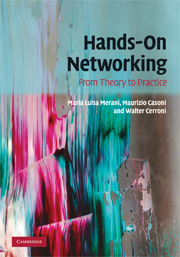8 - Wide area networks and user access
Published online by Cambridge University Press: 05 June 2012
Summary
This final chapter is dedicated to a brief overview of some of the most important solutions used by network operators, on the one hand, for providing access to their customers, on the other, as wide area network (WAN) technologies are adopted in the network core. The chapter starts with an overview of the xDSL family, one of the most popular access technologies adopted today. Then a historical perspective of WAN technologies is given, going from the X.25 and ISDN solutions to the more recent frame relay service and ATM protocol. The attempt made by IETF to join the flexibility of the connectionless IP world with the advantages of the connection-oriented ATM approach is, finally, the basis for introducing the principles of MPLS, a very popular technology currently used by operators to offer enhanced IP-based connectivity services to their customers, including quality of service guarantees and tunneling capabilities. Given the importance of the last topic, the chapter closes with a section dedicated to a practical example of MPLS router configuration.
The xDSL family
The xDSL acronym refers to a set of solutions and technologies developed for supporting the transmission of high speed data in existing copper access networks. It also supports data transmissions at long distances but at lower bit rates.
The ITU-T recommendation G.995.1 [91] provides an overview of the digital subscriber line family. In the following ADSL, with the recent ADSL2 and ADSL2+, HDSL, SHDSL, VDSL and VDSL2 will be presented.
- Type
- Chapter
- Information
- Hands-On NetworkingFrom Theory to Practice, pp. 220 - 247Publisher: Cambridge University PressPrint publication year: 2009



